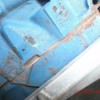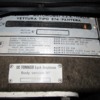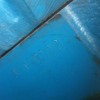Replies sorted oldest to newest
I believe the first Pantera equipped with a 351W was a GTS, chassis 9483, assembled in September 1986.
GT5-S Panteras assembled by Amerisport in the late 1980s were equipped with 351 Clevelands however, even when De Tomaso had transitioned to 351W engines. The Clevelands installed in the Amerisports were composed of NOS short blocks and rebuilt 2V cylinder heads (US head castings).
Engines shops right ? Thx
Original DeTomaso motor has 4 digit stamp number on left rear block by head.
Larry / Jack/ George feel free to correct.
Attachments
psl: you guys never heard of brand new cars in eary 80's getting fitted with overbored / overhauled engine at the assembly line . correct?
quote:Originally posted by Adriano.S.:
… fitted with overbored … engine?
quote:Originally posted by Adriano.S.:
… Any real facts much apreciated!
This Cleveland looks like it was "overboard" … real fact
Attachments
quote:Originally posted by Denis C:
if they were 'used' or 'rebuilt' blocks , you should find a VIN on the motor (left rear, just below head gasket)
Original DeTomaso motor has 4 digit stamp number on rear LH head.
Larry / Jack/ George feel free to correct.
Very interesting that the number you refer to there is a VIN number from another car, I just thought it was some kind 'block number' for a aftermarket replacement. My block has just such a number on it, any idears on how to find out what car it came out of?
Cheers, Tim.
http://www.provamo.com/Members...y/SearchMotorNum.asp
quote:Originally posted by Timsteren:quote:Originally posted by Denis C:
if they were 'used' or 'rebuilt' blocks , you should find a VIN on the motor (left rear, just below head gasket)
Original DeTomaso motor has 4 digit stamp number on rear left block near head.
Larry / Jack/ George feel free to correct.
Very interesting that the number you refer to there is a VIN number from another car, I just thought it was some kind 'block number' for a aftermarket replacement. My block has just such a number on it, any idears on how to find out what car it came out of?
Cheers, Tim.
if the number starts looks like 1H123456 it is year, plant, sequential. in the case of my picture it would be a 1973 block from a Lorrain plant 'H' end of VIN 159302. in 73 Lorrain was producing Torino. You can send number to Marti, it will cost you research fees and he can tell what the motor came from.
this is a Pantera engine VIN
Attachments
quote:Originally posted by Timsteren:
Very interesting that the number you refer to there is a VIN number from another car, I just thought it was some kind 'block number' for a aftermarket replacement. My block has just such a number on it, any idears on how to find out what car it came out of?
I've never seen a decoder for engine numbers, not even in a Ford engine manual. I do not remember them matching the VIN numbers of the car they are installed in however. (But neither do I remember what I did yesterday)
I interpret the engine number in the picture thus, but this is only my guess:
3 = the year, 1973
H = the engine code, H is the code for a 351 2V, includes both Windsor or Cleveland
159302 = consecutive number
Light blue paint = Cougar or Montego (i.e. Mercurys). Fords were a darker blue called Ford corporate blue.
I'll bet one of the digits in the consecutive number specifies the engine plant, but I can't say for sure. For instance the first number of the consecutive number in a VIN indicates make & model: 1 = certain Fords, 5 = certain Mercurys, 8 = Lincolns. Can't believe I still remember those numbers, hint: 1 included Mustangs, 5 included Cougars.
I can say for sure ALL Cleveland engines were assembled in Cleveland Engine Plant No.2, in Brookpark Ohio (by the proud members of UAW local 1250). Brookpark is a suburb of Cleveland. The folks at the engine plant had no idea exactly which car the engine was going to be installed in, not capable of assigning a VIN to an engine. The engines were transported to the various vehicle assembly plants.
On the other hand, I may be 100% wrong.
Attachments
quote:
Originally posted by The Reaper:
This Cleveland looks like it was "overboard" …
I appreciate a little levity now and then. Thnx for the laugh.
Attachments
In your second example, the one in the VIN and the dark blue paint are in agreement. In the first picture the one in the VIN and the light blue paint are in conflict.
Ford Blue paint is all another subject. The best explanation I have was done by Mustangs and Fords a few years back
http://www.mustangandfords.com...ustang-engine-paint/
High end restoration shops have for years approached it differently, they thoroughly clean the motor find the best sample and mix paint to match.
quote:Originally posted by Denis C:
$25 later Marti standard report from the short engine VIN. I have done this 3 times.
Many thanks to all! This has been a very interesting learning experience. I think I will see what Marti has on my (non-Pantera) block. I would love to get the actual block (6294) originally belonging to my car , so that I have matching numbers, but it was probably melted down a long time ago.
Cheers, Tim.
Ford used the "sequence number" on the block....which is the last 6 digits of the VIN number of the car.
Different production lines used different numbers.... All Cougars started with 500000, Torinos as noted with 100000 Mustangs may have been same as Torinos, or simply 000000, I can't recall.....
But as George noted, first digit is typically the production year ie 3=1973. Not the date the block was cast. That would be the casting date!
What no one seems to have done much work on, was tracking casting dates to Pantera assembly/sales/production dates.... Would be quite the task!
If DeT got engines from the spare parts line they could have older dates....if they came from the engine plant directly, they should be fairly close to the production of the car....
SOOOO, your production dates on the block could vary....and to say what is correct for your particular car, knowing DeT's production line crazys...is really tough.
One really shouldn't be concerned at all with the VIN number stamped into the back.......
What tells you the most about your engine, is the casting number, the date code, and the dimensions of the cylinders.
If any one needs help with the numbers, drop me a line....but these are well published and can be found in the "How to Rebuild Your 351C" book also. I have the Ford Master Parts Catalog that the dealership used. Up thru 1972, last printing 1975.
Keep in mind that many parts on your engine have date codes that should be fairly close together, just like glass dates on the body!
Block, heads, intake, carb, distributor, harmonic balancer, water pump, fuel pump, flywheel, temp sender (Ford version) to name most of them, all have date codes!!!!
Now, if you are already worrying about your block.....this should have you in cold sweats!!!
All known factory replacement blocks had NO stamped numbers; Ford warrantied engines but made no attempt to locate a 'proper' year. This does not include what may have happened at various concessionaire's shops in the different countries. I don't think DeTomaso had time to mess around rebuilding an unfamiliar engine for a brand new car, then doing the paperwork for reimbursement when Ford assemblies were as close as a telephone call.
denisc posted:$25 later Marti standard report from the short engine VIN. I have done this 3 times.
Hi all,
just reporting back to say that I have now done this with the block sitting in my 1974 Pantera, and sure enough, Marti was able to fish out the car that my block came out of, based on the number stamped on my block (2A271998). Here is a little excerpt from the report:
DOOR DATA PLATE INFORMATION Serial Number 2A38Q271998
2 1972
A Built at Atlanta
38 Gran Torino Sport 2-Door Hardtop
Q 351-4V Cobra Jet V-8 Engine
271998 Serial Number of this Ford scheduled for production at Atlanta
Cheers, Tim.
Ancient History: when Ford walked away from the Pantera project 'sometime' in 1974 (date varies with the source), DeTomaso began doing what he'd always done with non-U.S Panteras sold direct since '71: they were offered from Modena with all sorts of upgrades, options and enhancements never seen in Ford-marketed cars. One was higher-power versions of whatever engine the factory was offering at the time. This included Weber intakes & carb sets, Holley carbs, different cams & higher compression. In the '80s, regeared ZFs were popular. Some of the enhancements offered appear to be Speed-shop mods sourced from California and installed by the factory.
So I would NOT be surprised to find a factory-paperwork-verified Pantera (351-C or 351-W) with anything up to (but maybe not including) a stroker crank- which was uncommon in street engines in the early days. Also keep in mind that some owners used the factory as a Service Center for their cars during the '70s-'80s and had routine or even major work done there. So I could believe an overbored block, Boss heads, forged pistons, a reground crank or regeared ZF etc from DeTomaso as a freshening or repair.
Note also that a few Euro-owners of such 'enhanced' powertrains bought new- sourced through concessionaires for each country- have been rumored to occasionally discover a stone-stock motor inside, even though their original bill of sale lists a '350 bhp (or more) engine'. What happened? Don't know; nearly all the participants have passed on and 30-40 years ago is a LONG time ago to try to trace out such details on a limited production, essentially hand- built sports GT. I realize this doesn't clarify things much for you- sorry.
In theory that would be documented in the factory paperwork.







